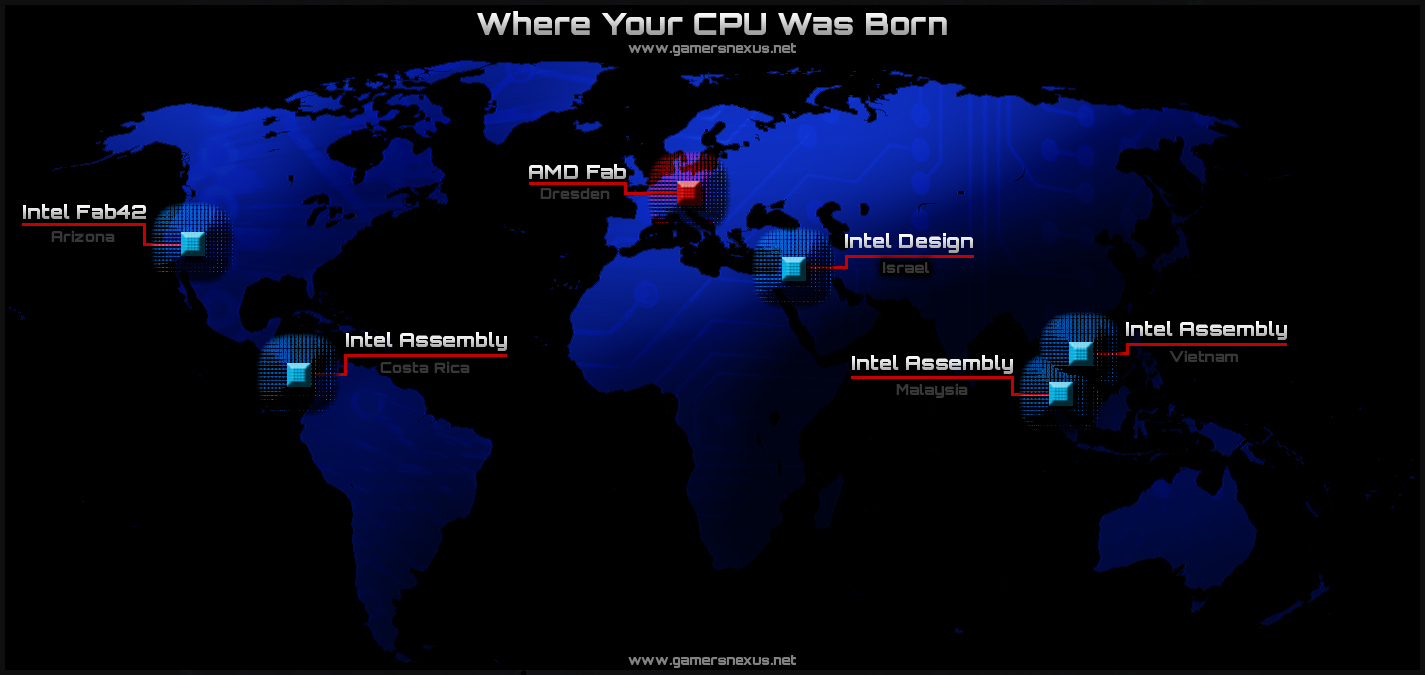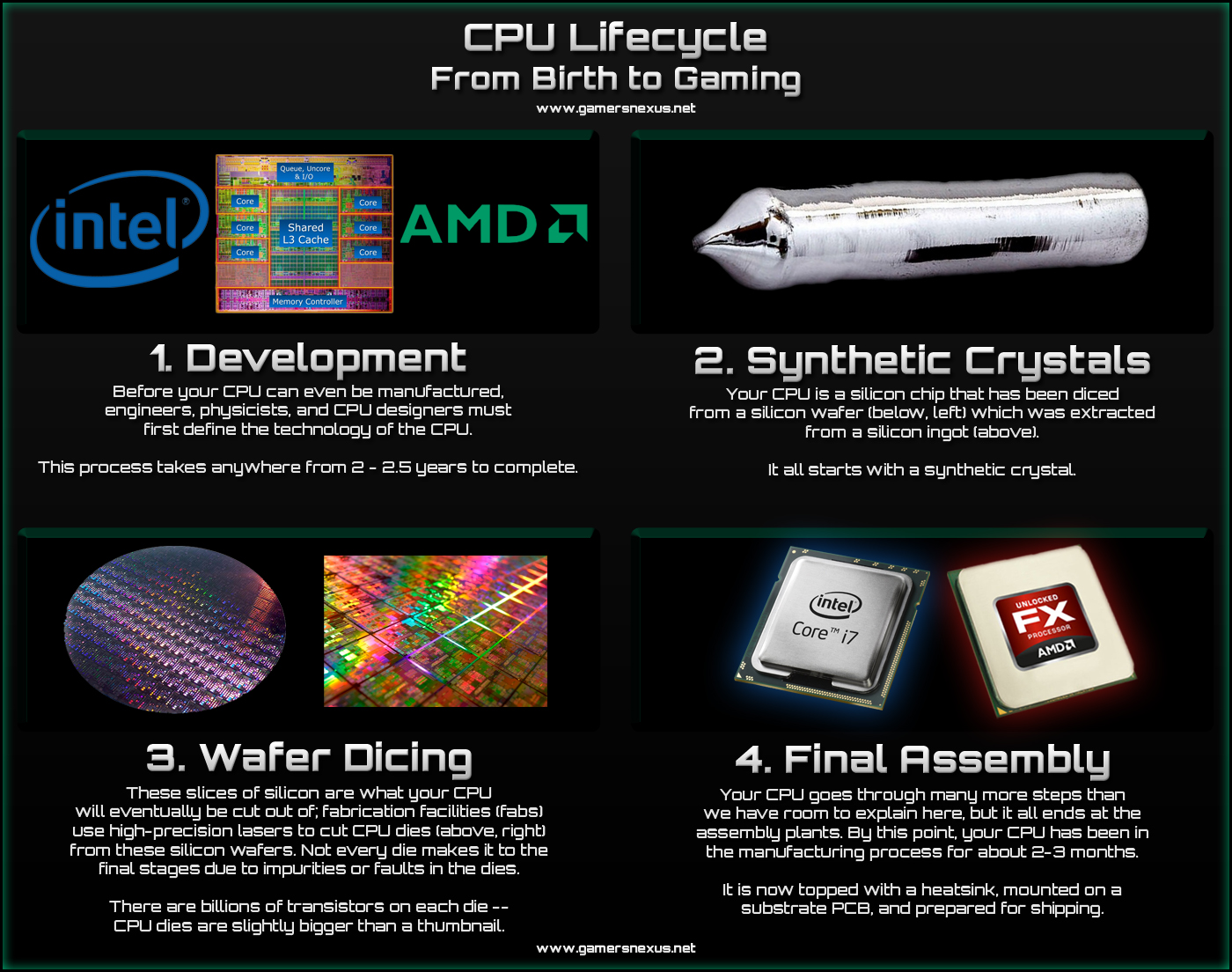As hardware and gaming enthusiasts, it's easy to acknowledge the sheer amount of complexity behind the continual stability exhibited by high-end gaming CPUs and components. The basics of processing technology advance in pendulous, perfectly-timed swings with each passing iteration of Intel and AMD's respective flagship models; enthusiasts can certainly appreciate the level of performance gained with, for example, the institution of Sandy Bridge architecture, or to go old-school, the implementation of hyperthreading on P4 CPUs. Even in non-CPU examples, the evolution of SSDs and their usefulness is worthy of mention, albeit somewhat ignored. It's something we experience every day: The changes of these technologies are instantly visible through virtue of playing games and using applications.
So the engineering behind each chip is appreciated -- but the manufacturing process (2 - 3 months), the development process (a full 2 - 2.5 years), and the unbelievable level of science behind the two in combination are hardly noticed when reading up on budget gaming rigs or explaining the functionality to newcomers. All of this comes down to one question: Where and how are CPUs made? We'll answer the latter in an extensive series, but the rest remains below...
 Several other factories exist. Fab32 is also in Arizona and manufactures modern chips, Fab42 is up-and-coming.
Several other factories exist. Fab32 is also in Arizona and manufactures modern chips, Fab42 is up-and-coming.
Click to enlarge.
Quick note: Most of AMD's wafer and die manufacturing is handled by GlobalFoundries, a third-party, and their fabrication and assembly plants are not easily pinpointed in respect to AMD's CPUs. There are more out there, to be sure, but this map only shows what we have publicly available.
In terms of Intel, since we have their data more publicly available, here are some of the fab locations not included on the above map:
- FabD1D - 22nm manufacturing (Oregon)
- FabD1C - 32nm manufacturing (Oregon)
- Fab32 - 45/32nm manufacturing (Arizona)
- Fab11x - 45/32nm manufacturing (New Mexico)
Fabrication ("Fab") plants are some of the most expensive, technologically-innovative manufacturing centers on the planet. Intel has several fabrication facilities in the US, to include Fab32 in Arizona (45/32nm architecture), FabD1D in Oregon (22nm architecture), the up-and-coming Fab42 in Arizona (planned 14nm architecture), and several more that work tirelessly to produce the processors we consume oh-so-readily.
These fabrication plants cost upwards of $5B to build and -- despite looking like something straight out of Mirror's Edge on the outside -- are bursting at the seams with some of the coolest manufacturing robots you've ever seen (video below). That isn't to leave out the role that humans play in this manufactory, though: Intel, which is the largest private employer in Oregon, has a 24/7 work schedule that has staff on-site at all hours of the day, ticking like clockwork to thwart arising issues. Granted, at least an hour of each day is spent putting on those extremely fashionable white suits.
There's no sound in the above video -- it's just cool machines and factories.
Fabrication plants are filled with rooms of differing disciplines, but the most commonly-cited room is the "clean room." These areas are the stuff of sci-fi movies ("two-by-two, hands of blue" was a reference to Intel, no doubt): Employees don stark white, jealousy-inducing clothing, secure their hair under white hoods, and work in a completely dust-free environment. A single particle of dust can render a CPU die useless (the tiny chip behind your processor), and the more "good" dies that emerge from factories, the higher the yield-per-wafer and overall profit.
 Click to enlarge this infographic.
Click to enlarge this infographic.
After going through their round of initial slicing-and-dicing in the fabrication plants, the dies are shipped off to final assembly locations. Final Assembly is where the CPU starts to take the shape of something we recognize: the die is mounted to the recognizable green PCB, a heatsink is fastened to the chip, and the processor is prepared for shipping. By this period in the process, that single CPU has been in the making for around 2 - 3 months (explaining some of those "slow" corrections we see) and was in development for around 2 - 2.5 years prior to that. This is true for both AMD and Intel with minimal scheduling variations. As an end-user, the level of depth behind something that can be roasted by a single zap of ESD makes you feel, well, quite insignificant in the world of electronics.
We have an entire article series coming that explains these factories in great detail and aims more specifically at individualized advances in CPU manufacturing and development, so check our newly-added Hardware Guides page for regular updates. As always, feel free to comment below with questions/comments or visit our forums!
Hopefully this writing gives a bit of perspective as to where, exactly, your CPU originated from and how expensive its journey was. Just think: You own something that was in a $5B building and was handled by machines that are, quite possibly, the beginning of SkyNet. That's basically the same as being rich, right?
Close enough.
-Steve "Lelldorianx" Burke
A huge thanks to silicon expert and friend Milind Karnik for his help in elaborating on this truly remarkable industry.